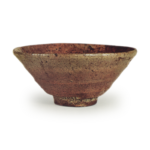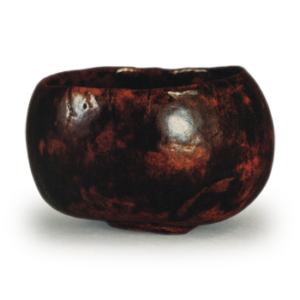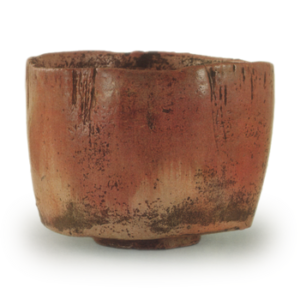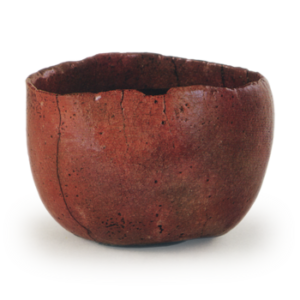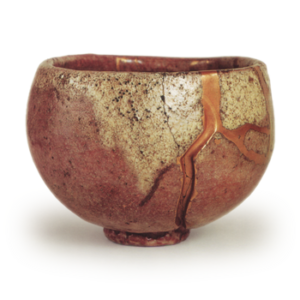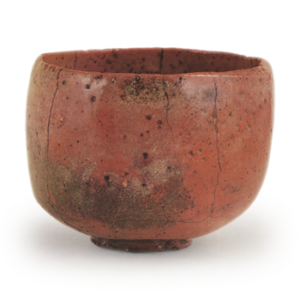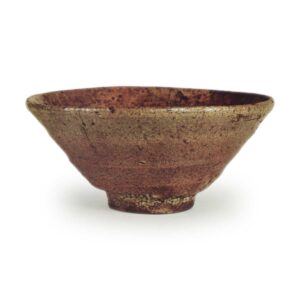
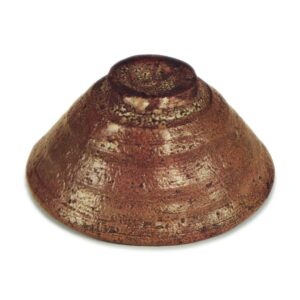
Height: 6.5 – 6.8 cm
Diameter: 14.6 – 14.7 cm
Outer diameter of foot: 5.1 cm
Height of foot: 0.9 – 1.0 cm
In recent years, the consensus among tea ceremony enthusiasts is that the most famous Aoido bowls are those made by Shibata and Hōju-an. It seems that Ujiiro and Yamanoi are also included in this, but while Shibata’s bowls are lacking in the blue color that defines Aoido, Hōju-an’s bowls have the exact glaze color that makes them worthy of the Aoido name.
The overall thickness of this piece is slightly greater than that of Shibata’s, and from the foot to the rim, it is rich in a dignified atmosphere, with extremely strong wheel marks. In particular, the strength of the foot, which has been deeply scraped with a spatula and clearly carved, is probably the strongest of all Aoido pieces.
In addition, from the foot to the rim, the four straight lines of the wheel marks spread out. The foot, which tapers slightly towards the tatami mat, is also carved in a way that resembles a bamboo joint, and it leans slightly to one side. The kaaragi (Japanese lacquerware technique of inlaying thin pieces of wood or shell into the lacquerware) that extends from the foot to the rim is particularly beautiful, and the white areas that appear clearly in some places add a touch of elegance to this tea bowl.
The glaze on the outside is quite thick, and the surface is divided into two halves, one with a strong blue hue and the other with a reddish hue, but the overall color tone is full of a subdued flavor.
The inside of the bowl is deeper from the waist to the middle, and the marks left by the potter’s wheel are quietly circling, hiding their sense of power. There appear to be about five marks left, but they are not large or small, and are not clear. It is more of a famous bowl with excellent workmanship on the outside, especially on the foot, than on the inside.
There are four or five small repairs and cracks on the rim, but they are hardly noticeable.
According to the Taisho Meiki Kan (A Guide to Famous Vessels of the Taisho Period), the Hōju-an mark was owned by a tool merchant in Osaka called Katsubei, or Dōkatsu, who used the name Hōju-an.
According to the “Fushimiya Te-hiki” (a record of the Fushimiya tea utensil store), it is said that the owner before Michikatsu was a Kyoto-based tea utensil dealer called Taruya, and it is thought that the tea bowl was already called Hōju-an when it was in the possession of Taruya.
Anyway, according to tradition, it was a tea bowl that originally came from Inuyama in Owari, and after passing through Taruya, it came into the possession of Dokusho, and after Dokusho’s death, it was passed down in the family, but at the beginning of the Meiji era, it was purchased by the rice merchant Tadahei Matsuoka of Kanazawa for 800 yen. At the time, 800 yen was a very large sum of money, and it is said that the name of the Matsuoka family of Kaga became known among the tea ceremony enthusiasts for the first time.
The gold-powdered characters on the inside of the lid of the tea bowl, “Hōju-chawan”, are said to be the work of Kobori Yōro, or Masaan, and as Yōro died on January 1st, 1876 at the age of 61, it is thought that this inscription was written sometime between the mid-1850s and 1876. Therefore, it is thought that the tea bowl came into the possession of Dōshō sometime after the mid-1850s. In addition, a small colored paper with the words “I feel as if I can see the shade of the tree on the snow-covered branches of the snow-covered branches of the snow-covered branches of the snow-covered branches of the snow-covered branches of the snow-covered branches of the snow-covered branches of the snow-covered branches of the snow-covered branches of the snow-covered branches of the snow-covered branches of the snow-covered branches of the snow-covered branches of the snow-covered branches of the snow-covered branches of the snow-covered branches of the snow-covered branches of the snow-covered branches of the snow-covered branches of the snow-covered branches of the snow-covered branches of the snow-covered branches of the snow-covered branches of the snow-covered branches of the snow-covered branches of the snow-covered branches of the snow-covered branches of the snow-covered branches of the snow

